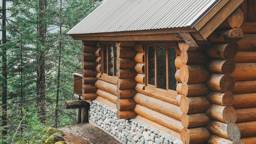 Most of us need a mortgage to finance new home construction. That means convincing a lender it’s safe to loan you a large chunk of money. And, since traditional lenders often finance only 80 percent of a primary residence’s appraised value (some, including log home mortgage companies, may finance more), you must come up with the remainder—the down payment—with cash or equity in your property. But how do you make all that happen? With hard work, discipline and, most importantly, financial planning. We’ll leave the discipline part up to you, but when it comes to sorting out your finances, we turned to the experts. Log home mortgage specialists helped us develop a timeline for financing a new log home starting 10 years before construction begins. (Yes, you should start preparing as much as a decade before breaking ground!) Here’s what they suggest. 10 Years Out >> Now is the time to strengthen your financial position. Decide how you’ll pay for your land, construction, down payment and closing. “Save as much as you can, as early as you can,” advises Andy West, a financial advisor with Merrill Lynch in Rockford, Illinois. Stick to low-risk savings vehicles and consider contributing more to a retirement plan that allows you to borrow against it. >> Pay your bills on time and minimize consumer debt to improve your credit rating. This will increase your chances of getting the mortgage you want. Also keep in mind that this is not the best time to switch professions. “Lenders look for continuity of income,” West cautions. “Changing jobs is fine, but making a major career change is not a good idea.” >> If it’s a buyers’ market, look for that perfect piece of land. “Finding land this far in advance is wise because it gives people a chance to pay off the balance and make improvements to the property,” notes Mike Cole, assistant vice president of M&T Mortgage, in Lancaster, Pennsylvania. >> Start developing your property. If you’ve already bought land, think about making improvements, like installing a well. It increases your equity and reduces the amount you have to borrow later, but ask your financial advisor whether it’s better to spend money on developing your land now—when costs may be less—or to keep your cash in interest-bearing accounts. Keep receipts for improvements, but be aware that the value a lender assigns a renovation may not equal its actual cost. 5 Years Out >> Keep saving. The most important step of all. >> Continue paying off your land. If you haven’t found land yet, make that your top priority. >> Start checking your credit reports annually and correct errors. Most transactions stay on your record at least three years and often longer. If your credit history is spotty, clean it up by paying bills on time and reporting any inaccuracies on your report. Also, increase your cash reserves to bolster your financial standing. >> Get up close and personal with log-home companies. Go to open houses and home shows, and check out log magazines to research providers to get a better idea of what you want in your home and, therefore, how much it will cost. “The average log homeowner spends three to five years planning before he actually starts building,” Cole says. 2 to 3 Years Out >> Narrow your pool of log-home companies and builders and fine-tune your cost estimates. Your decision may be as simple as choosing who’s closest to your building site or who’s offering the most complete package. >> Get a preliminary appraisal. To determine your loan amount, lenders require an appraisal comparing your future home to other local homes. These “comps,” as they’re called, are usually required to have been sold in the prior six to 12 months. >> Contact lenders to learn their requirements and the types of mortgages they offer. Most specialists recommend a “one-step” construction-to-permanent loan, which provides money during construction. Upon completion of your home, it converts to an already-negotiated, permanent mortgage without the need for a second set of closing costs. Doug Groff, vice president of American Log Mortgage, in Mountville, Pennsyl-vania, also recommends using a lender that specializes in log homes. “Sometimes traditional lenders don’t know the right questions to ask,” he says. “You don’t want a lender practicing on you.” 1 Year Out >> Make final arrangements with your builder and log-home company. Many log-home companies will lock in your construction price for a year or more. >> Choose your lender and arrange for a construction loan/mortgage pre-qualification. This is a non-binding analysis that helps you predict what you can borrow when you file your formal mortgage application. >> Take a deep breath. You’re heading into the home stretch! |
Your Financial Countdown | Log Home Financing Plan
It's your dream to build your own log home. But how will you afford it? Follow this timeline and 3 ... 2 ... 1 ... Happy New Home!











